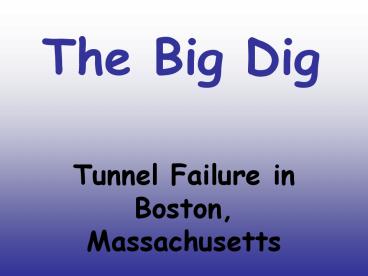The Big Dig - PowerPoint PPT Presentation
1 / 20
Title:
The Big Dig
Description:
... Ted Williams Tunnel, the Zakim Bunker Hill Bridge, and the Rose Kennedy Greenway. ... Ramp D connects the Ted Williams Tunnel westbound to Interstate 93 ... – PowerPoint PPT presentation
Number of Views:1250
Avg rating:3.0/5.0
Title: The Big Dig
1
The Big Dig
- Tunnel Failure in Boston, Massachusetts
2
Outline for our Presentation
- What is the Big Dig and some other general facts
about it - Planning for the project and what it took to
start it - The construction and various problems it had
3
What is the Big Dig?
- The Central Artery/ Tunnel Project (unofficially
known as the Big Dig) was a huge project that was
designed to reroute Interstate 93 (The main
highway in Boston) into a 3.5 mile tunnel under
the city.
4
More Facts About the Tunnel
- This project is the single most expensive high
project ever done in America. - The project was estimated to cost 2.5 billion
dollars in 1985 but to the day the U.S. has spent
over 14.6 billion dollars on the project. - Along with the tunnel the project also included
the Ted Williams Tunnel, the Zakim Bunker Hill
Bridge, and the Rose Kennedy Greenway.
5
The Start of the Big Dig
- The idea for the Big Dig was first thought of in
the 1970s though planning for it did not start
until 1982. - It was not until 1987 that the bill was passed by
the U.S. congress to give sufficient funds for
the project. - The tunnel was proposed because of the
constantly congested streets in Boston. - The tunnel was proposed to replace the six lane
central artery that runs through there.
6
The Central Artery
- The is what the dig
- looked like during its
- construction heading
- South bound.
7
Planning
- 1983- Environmental impact studies began,
approved in 1985 - 1987- U.S. Congress passes bill for Federal
Funding allocating 755M for the project.
President Regan initially vetoed the project but
was overrode by Congress. - 1991- Ground was first broken for Big Dig
8
Breaking Ground
- In addition to political and financial
difficulties, the project faced several
environmental and engineering obstacles. - Constructions area was largely landfill, and
included existing subway lines as well as many
pipes and utility lines that would have to be
replaced or moved. - Many unexpected geological and archaeological
obstacles were found, ranging from glacial
remains to foundations of buried houses and a
number of sunken ships lying within the
construction area. - More concerns included release of toxins by the
excavation and the possibility of disrupting the
homes of millions of rats, causing them to roam
the streets of Boston in search of new housing.
9
Construction Stages
- Engineers had to use high-tech and expensive
construction techniques in order to allow traffic
to flow with out restriction. - In order to support the existing freeway above
the city streets, engineers built 120 ft.-deep
concrete walls upon which the highway could rest. - The Charles River crossing was one of the most
controversial aspects of the project, as it was
difficult to find a cost effective way to cross
the River. The Zakim bridge was the final
decision, which is the worlds widest cable
stayed bridge.
10
(No Transcript)
11
Finishing Touches
- Two major companies, dozens of sub-projects, and
over 5,000 workers worked to finish the project. - Boston Began opening various section of the
underground highway as early as January of 2003
and was fully open January 13th 2006. - In 2004 the elevated Central Artery (I-93) was
dismantled.
12
Big Dig Problems
- The project was estimated at 2.5 billion in
1985, but total expenses eventually surpassed 15
billion. - On July 11, 2006, the I-90 connector tunnel was
closed indefinitely as twelve tons of ceiling
concrete in the tunnel collapsed on a car killing
a woman and injuring others. - After doing several experiments, engineers
determined that substandard materials were used,
that may have caused several leaks in the ceiling
as well as the collapse.
13
(No Transcript)
14
(No Transcript)
15
(No Transcript)
16
Romney Takes Action
- Romney hired an Illinois consulting firm to do a
stem to stern inspection of the site - Ordered July 14th (4 days after incident)
- Roads were found to be, fundamentally safe
- Many Problems found throughout the site
17
Problems
- Bend in a bracket holding a cable that supports 1
million pounds of pressure - Bolt-Epoxy system failed
- Concrete cracks in the support
- Fire Alarm and Detection System need improvement
- Ventilation System
18
Green- Viaduct Orange-
Transition Yellow- At Grade Blue-
Tunnel
http//www.massturnpike.com/img/big_dig/multimedia
/maps/completion_lg.jpg
19
Ted Williams Tunnel
- Ramp from South Boston to Ted Williams Tunnel
opened in August (Eastbound Lanes). - Ramp D opened last Wednesday Nov 22nd
- Ramp D connects the Ted Williams Tunnel westbound
to Interstate 93 - The reopened ramp represents only about 10
percent of the total area of the Big Dig tunnels
and ramps that have been shut down. Other
sections could take months to inspect and reopen,
Romney said.
20
Bibliography
- http//www.masspike.com/bigdig/index.html
- http//en.wikipedia.org/wiki/Big_Dig
- http//www.boston.com/news/specials/big_dig_ceilin
g_collapse/ - http//www.thebostonchannel.com/news/10382277/deta
il.html








![get⚡[PDF]❤ Archaeologists Dig for Clues (Let's-Read-and-Find-Out Science 2) PowerPoint PPT Presentation](https://s3.amazonaws.com/images.powershow.com/10049521.th0.jpg?_=20240607027)






















